Title: Hargeisa to Garowe
Dates: 2nd to 10th August GPS:
Distance: 697km Total Distance: 21,455km
Roads: tarmac, some mountains, open plains
Weather: Very hot and extreme winds, most cross winds, two good days of tail winds.
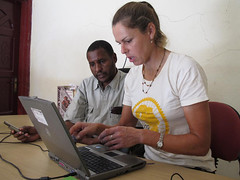 Our two days in Hargeisa were extremely busy learning about some of the many projects Omer’s Taakulo Somaliland Community is undertaking and ensuring the right security plan is put into place for our journey through Somaliland. It was hectic. On the security side, the process was set in motion when we consulted the National Security Advisor for NGOs. Yusef agreed to consult all traditional leaders in the sensitive areas from Burao to Las Anod and then the Somaliland side after Las Anod, near the disputed buffer zone between Somaliland and Puntland. The result was positive and the following day he set up a meeting with the chief of police. Again we received the all clear and he wrote an official letter for us to present at all checkpoints when required. We also had to apply for visa extensions as immigration would only give a seven day visa initially. All parties warn us of the dangers but when they learn about the expedition and the back-up we have planned, they have given us permission to go through. Somaliland is a peaceful country but Al Shabab is present and in recent times have blown up three key sites in Hargeisa. Ever since they killed two NGOs on the main road between Hargeisa and Berbera (in 2007 I think), the Somaliland government has vowed to protect visitors. Omer arranged for us to be protected by two security guards, Abdul and Karim (trained by the British army). I also took the decision not to publicise our intended route to Las Anod and Puntland for security reasons.
Our two days in Hargeisa were extremely busy learning about some of the many projects Omer’s Taakulo Somaliland Community is undertaking and ensuring the right security plan is put into place for our journey through Somaliland. It was hectic. On the security side, the process was set in motion when we consulted the National Security Advisor for NGOs. Yusef agreed to consult all traditional leaders in the sensitive areas from Burao to Las Anod and then the Somaliland side after Las Anod, near the disputed buffer zone between Somaliland and Puntland. The result was positive and the following day he set up a meeting with the chief of police. Again we received the all clear and he wrote an official letter for us to present at all checkpoints when required. We also had to apply for visa extensions as immigration would only give a seven day visa initially. All parties warn us of the dangers but when they learn about the expedition and the back-up we have planned, they have given us permission to go through. Somaliland is a peaceful country but Al Shabab is present and in recent times have blown up three key sites in Hargeisa. Ever since they killed two NGOs on the main road between Hargeisa and Berbera (in 2007 I think), the Somaliland government has vowed to protect visitors. Omer arranged for us to be protected by two security guards, Abdul and Karim (trained by the British army). I also took the decision not to publicise our intended route to Las Anod and Puntland for security reasons.
 Taakulo in Somali means ‘to help’. Omer’s Taakulo Somaliland Community (TSC) is certainly making a difference to many who are in need in Somaliland. In particular the TSC focuses on clean water, hygiene and sanitation, education, health issues and empowering women. They partner with many international organisations to ensure their expertise and funds are directed to those who most need assistance.
Taakulo in Somali means ‘to help’. Omer’s Taakulo Somaliland Community (TSC) is certainly making a difference to many who are in need in Somaliland. In particular the TSC focuses on clean water, hygiene and sanitation, education, health issues and empowering women. They partner with many international organisations to ensure their expertise and funds are directed to those who most need assistance.
 We first visited the Hargeisa Group Hospital. The public 450-bed hospital is the only one serving Hargeisa, population approximately 800,000. It was built by the British in 1952 when Hargeisa had about 10,000 people, so the city is crying out for more hospitals equipped with better facilities. Structurally the buildings are in urgent need of repair; walls and ceilings are leaking, there are bullet holes and shrapnel damage from the civil war in the 1980s.
We first visited the Hargeisa Group Hospital. The public 450-bed hospital is the only one serving Hargeisa, population approximately 800,000. It was built by the British in 1952 when Hargeisa had about 10,000 people, so the city is crying out for more hospitals equipped with better facilities. Structurally the buildings are in urgent need of repair; walls and ceilings are leaking, there are bullet holes and shrapnel damage from the civil war in the 1980s.
 Most equipment is worn out and needs updating. There are limited numbers of teaching professionals to train new local medical students and healthcare workers. The TSC is working with Australian Doctors for Africa (ADFA), a Perth-based organisation which sends small teams of orthopaedic surgeons and medical professionals to Hargeisa (and Bosaso in Puntland; Ethiopia and Madagascar) to perform stints of much needed surgery, provide medical training and provide supplies and equipment. They are also raising funds which are used to renovate the dilapidated infrastructure. They may be a small organisation but they seem to be changing the lives of many – I have not listed everything they do, but to find out more, please visit their website at www.austdocafrica.iinet.net.au.
Most equipment is worn out and needs updating. There are limited numbers of teaching professionals to train new local medical students and healthcare workers. The TSC is working with Australian Doctors for Africa (ADFA), a Perth-based organisation which sends small teams of orthopaedic surgeons and medical professionals to Hargeisa (and Bosaso in Puntland; Ethiopia and Madagascar) to perform stints of much needed surgery, provide medical training and provide supplies and equipment. They are also raising funds which are used to renovate the dilapidated infrastructure. They may be a small organisation but they seem to be changing the lives of many – I have not listed everything they do, but to find out more, please visit their website at www.austdocafrica.iinet.net.au.
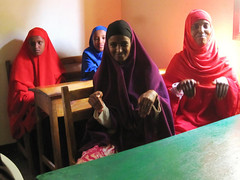 Over the two days in Hargeisa, we also visited Hargeisa School for the Deaf, the Disability Action Network, Somaliland Special Education School and Caritas. TSC partner all of these organisations. Somaliland has an estimated population of 3-5 million – 11% are disabled in some way. Each of these organisations is responsible for enabling those with disabilities to maximise their potential and integrate with and contribute to society to lead more productive lives. These organisations improve self-esteem and social status.
Over the two days in Hargeisa, we also visited Hargeisa School for the Deaf, the Disability Action Network, Somaliland Special Education School and Caritas. TSC partner all of these organisations. Somaliland has an estimated population of 3-5 million – 11% are disabled in some way. Each of these organisations is responsible for enabling those with disabilities to maximise their potential and integrate with and contribute to society to lead more productive lives. These organisations improve self-esteem and social status.
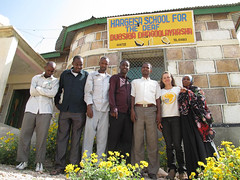 At the Hargeisa School for the Deaf (HSD) we were shown around by Yasmin Abdirahman, the Director. The organisation was set up by parents of hearing impaired children. Before the HSD deaf people did not have a chance to go to school in Somaliland. (To contact Yasmin: hsdeaf@yahoo.com) The Somaliland Special Education School caters for a wide range of disability categories. Many are taught at home and the school sends out teachers to oversee their learning. They also recognise the need for adult women to improve their education by providing basic education and vocational learning, such as tailoring. The TSC have a child sponsorship program to ensure more children can afford to go to school. He handed over some donors’ contributions while I was there. The Disability Action Network is a physiotherapy centre focussed around getting people up and mobile. Equipment such as wheel chairs, crutches and prostheses are made there, often by improvising with whatever materials are available. The TSC has contributed by providing wheelchairs and other equipment.
At the Hargeisa School for the Deaf (HSD) we were shown around by Yasmin Abdirahman, the Director. The organisation was set up by parents of hearing impaired children. Before the HSD deaf people did not have a chance to go to school in Somaliland. (To contact Yasmin: hsdeaf@yahoo.com) The Somaliland Special Education School caters for a wide range of disability categories. Many are taught at home and the school sends out teachers to oversee their learning. They also recognise the need for adult women to improve their education by providing basic education and vocational learning, such as tailoring. The TSC have a child sponsorship program to ensure more children can afford to go to school. He handed over some donors’ contributions while I was there. The Disability Action Network is a physiotherapy centre focussed around getting people up and mobile. Equipment such as wheel chairs, crutches and prostheses are made there, often by improvising with whatever materials are available. The TSC has contributed by providing wheelchairs and other equipment.
The best way to contribute to the TSC in Somaliland is to contact Omer at: taakulosom@gmail.com, or via the TSC website (or click on the TSC logo on the Partners’ page). The website is currently under construction but should be up and running in a couple of weeks.
 Omer invited us to his home for lunch – well feast! Omer’s wife produced an enormous quantity of food; goat meat, rice, salads, watermelon juice, fruit… She then presented me with a dirac and scarf to use when I am off the bike and in villages where there are more likely to be extremists.
Omer invited us to his home for lunch – well feast! Omer’s wife produced an enormous quantity of food; goat meat, rice, salads, watermelon juice, fruit… She then presented me with a dirac and scarf to use when I am off the bike and in villages where there are more likely to be extremists.
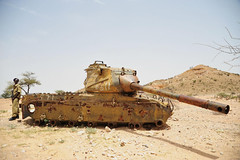 Just before leaving Hargeisa Omer introduced me to Seyid, the secretary to the new president. A couple of months before I arrived in Somaliland, the country had peaceful democratic elections. While the international community recognises Somaliland as a part of Somalia, Somaliland operates as a separate country. They say that the main hurdle which prevents official recognition is that the dysfunctional federal government in Mogadishu does not want to let go. Most of the administration is made up of Diaspora – those who have left the country (mostly after the civil war), educated abroad in Western countries and chosen to return to make a difference to their homeland. They also inject much needed funds into the country to bolster and stimulate economic growth and help relatives living in Somaliland. Seyid and Omer are good friends even though they were in opposing political parties. Now in opposition, Omer is happy to work with the new government for a greater good of the country. Providing a stable, peaceful environment allows the government to attract international investment and assistance.
Just before leaving Hargeisa Omer introduced me to Seyid, the secretary to the new president. A couple of months before I arrived in Somaliland, the country had peaceful democratic elections. While the international community recognises Somaliland as a part of Somalia, Somaliland operates as a separate country. They say that the main hurdle which prevents official recognition is that the dysfunctional federal government in Mogadishu does not want to let go. Most of the administration is made up of Diaspora – those who have left the country (mostly after the civil war), educated abroad in Western countries and chosen to return to make a difference to their homeland. They also inject much needed funds into the country to bolster and stimulate economic growth and help relatives living in Somaliland. Seyid and Omer are good friends even though they were in opposing political parties. Now in opposition, Omer is happy to work with the new government for a greater good of the country. Providing a stable, peaceful environment allows the government to attract international investment and assistance.
 A Somali satellite TV network filmed my departure from Hargeisa; again I was careful not to publicise the intended route. I was aided by a decent tail wind and gentle downhill most of the 166km to Berbera. The landscape was very open, dry desert with sparse tree density. Half way to Berbera I passed through a rugged mountain range. Once through the mountains and down on to the windswept desert coastal plains, the temperature increased significantly well into the 40s with a moisture-sapping hot north-westerly wind. Berbera at the head of the Red Sea has been a strategically important port for many centuries. The Egyptians first used the port to transport frankincense. The Turks built a settlement there followed by the British. Somaliland was a British colony. The town was much smaller than I expected, but as we toured around I found the ramshackle, old, poorly maintained buildings and dusty streets very interesting. There is a lot of shelling damage from the civil war.
A Somali satellite TV network filmed my departure from Hargeisa; again I was careful not to publicise the intended route. I was aided by a decent tail wind and gentle downhill most of the 166km to Berbera. The landscape was very open, dry desert with sparse tree density. Half way to Berbera I passed through a rugged mountain range. Once through the mountains and down on to the windswept desert coastal plains, the temperature increased significantly well into the 40s with a moisture-sapping hot north-westerly wind. Berbera at the head of the Red Sea has been a strategically important port for many centuries. The Egyptians first used the port to transport frankincense. The Turks built a settlement there followed by the British. Somaliland was a British colony. The town was much smaller than I expected, but as we toured around I found the ramshackle, old, poorly maintained buildings and dusty streets very interesting. There is a lot of shelling damage from the civil war.
From Berbera we headed east towards Las Anod and the Puntland disputed border. I had a very tough ten hour day climbing away from the coastal plains and up through the Goolis Mountains. The side-head wind was so strong that I could only average about 11-12 km/hr. Once I had conquered a 10km climb through the spectacular range – the greenest part of Somaliland – the land levelled out and I was able to ride at a more normal pace. Burao had a very different atmosphere to Berbera. I didn’t feel so comfortable and our security guards were much more on edge. The region around Oog, where I reached the next night (150km from Burao) is much more of a security risk. While the traditional leaders had already been consulted when we were in Hargeisa, we were advised to speak with the head of the regional police force to gain his authority to pass through. This we did. I had a great chat to the chief of police as he spoke good English and he said we would not have any trouble. During the night at the basic hotel in Oog, our guards kept watch. At one stage I was awoken by gun shots. Some nomads had appeared from the bush and were shining torches at our vehicles, approaching rapidly and treating them as suspicious. Abdul said they did not heed his warnings and so fired two shots above their heads,
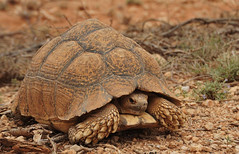 From Oog I knocked off 102km by noon to reach Las Anod, battling an incredibly strong side wind. The main reason for this was that my sister, Jane was due to fly in to Berbera the next day and our security guards had to drive back to collect her and bring her to join us. Las Anod is a real frontier town. Our hire vehicles were not permitted to be driven beyond the town as it is a lawless region. At the check point we were held up while the chief of police was consulted. To drive through the town, Abdul stood up through the sunroof of the LandCruiser surveying the town. I followed closely with the normal security car tailing me. This was not a place for us to spend time.
From Oog I knocked off 102km by noon to reach Las Anod, battling an incredibly strong side wind. The main reason for this was that my sister, Jane was due to fly in to Berbera the next day and our security guards had to drive back to collect her and bring her to join us. Las Anod is a real frontier town. Our hire vehicles were not permitted to be driven beyond the town as it is a lawless region. At the check point we were held up while the chief of police was consulted. To drive through the town, Abdul stood up through the sunroof of the LandCruiser surveying the town. I followed closely with the normal security car tailing me. This was not a place for us to spend time.
Some of the townsfolk were welcoming while others were not too positive about our being there. We were whisked away straight to the hotel; a quiet sanctuary on the edge of town. We were spotted by the local press who followed us to the hotel. I was interviewed for Somaliland TV. Again I was very careful not to reveal our intention of crossing into Puntland. The story was aired that night on the news. Strangely enough there isn’t a tourist industry at the moment, so we were the only customers for a while.
We had a day off in Las Anod but had to stay within the walls of the hotel (apart from a quick excursion to an internet cafe). Jane phoned early the next morning to say she had made the connecting flight from Dubai to Berbera. I had been very concerned because if for some reason she missed the flight, or the flight was cancelled, we had to go the next day through the buffer zone. This was to be a major security operation which Issa and the Puntland government had been working on for a week and Omer had been coordinating from Somaliland. I was only going to get one shot at cycling through the no man’s land. The day passed slowly for me – our guards were calling regularly updating Omer on their progress. Finally they arrived in the early evening. It was great to see Jane. Our reunion was a little emotional. I had not seen a member of my family for about 11 months and it felt strengthened by her support and commitment.
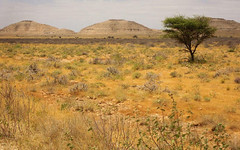 All of that strength was needed the next day. With no man’s land in front of us it was like D-Day. I felt genuinely nervous about the journey ahead. Issa had mentioned a few times that I had to prepare myself for the possibility that I may have to put the bike in a vehicle to cross the disputed zone between Somaliland and Puntland. He had been working with the Minister for Aviation who is a clan member and the government representative of that region. Negotiations had been going on for a week or so. He had also arranged substantial security from the Puntland end. We were unable to take our hire vehicles or police security guards from Somaliland past this point.
All of that strength was needed the next day. With no man’s land in front of us it was like D-Day. I felt genuinely nervous about the journey ahead. Issa had mentioned a few times that I had to prepare myself for the possibility that I may have to put the bike in a vehicle to cross the disputed zone between Somaliland and Puntland. He had been working with the Minister for Aviation who is a clan member and the government representative of that region. Negotiations had been going on for a week or so. He had also arranged substantial security from the Puntland end. We were unable to take our hire vehicles or police security guards from Somaliland past this point.
 Omer had to arrange for a local vehicle and driver who was willing to take us/accompany me to near the buffer zone – a village about 40km away where we would rendezvous with a vehicle from Puntland and security reinforcements. The person he was recommended refused to accompany me cycling (he wanted to put my bike in the car) and so Omer, knowing how important it was for me to complete the journey in a continuous line, found another driver willing to do the job. I am very appreciative of Omer’s persistence. We also took one local security guard in the normal estate car and set off at about 7.30am from Las Anod. Omer, Jane and Zdenek sat in the back; driver and soldier in the front. Omer had to keep in constant contact with Issa who had already started driving from Garowe, 130-odd kilometres away. The president of Puntland would not permit Issa, or any other member of the cabinet to pass through the buffer zone as they are too much of a target.
Omer had to arrange for a local vehicle and driver who was willing to take us/accompany me to near the buffer zone – a village about 40km away where we would rendezvous with a vehicle from Puntland and security reinforcements. The person he was recommended refused to accompany me cycling (he wanted to put my bike in the car) and so Omer, knowing how important it was for me to complete the journey in a continuous line, found another driver willing to do the job. I am very appreciative of Omer’s persistence. We also took one local security guard in the normal estate car and set off at about 7.30am from Las Anod. Omer, Jane and Zdenek sat in the back; driver and soldier in the front. Omer had to keep in constant contact with Issa who had already started driving from Garowe, 130-odd kilometres away. The president of Puntland would not permit Issa, or any other member of the cabinet to pass through the buffer zone as they are too much of a target.
 The good news for me was that I had a raging tail wind and was able to average nearly 30km/hr. The vehicle followed about 50m behind me. We passed through about six check points within the first 40km. Each time I arrived and waited calmly at the barrier and let the guard and Omer do the talking. The police commissioner’s letter organised in Hargeisa proved to be useful. Sometimes I was asked a couple of questions and usually shook the hands of the local clan’s people on patrol. Just after the village at 43km from Las Anod, the “Technical” military escort vehicle met us – exactly as planned.
The good news for me was that I had a raging tail wind and was able to average nearly 30km/hr. The vehicle followed about 50m behind me. We passed through about six check points within the first 40km. Each time I arrived and waited calmly at the barrier and let the guard and Omer do the talking. The police commissioner’s letter organised in Hargeisa proved to be useful. Sometimes I was asked a couple of questions and usually shook the hands of the local clan’s people on patrol. Just after the village at 43km from Las Anod, the “Technical” military escort vehicle met us – exactly as planned.
Technicals are old anti-aircraft units. The technical carries eleven men – driver, captain, gunner and eight regular soldiers. They escorted us through the buffer zone which was only about 10km wide. There was resistance at both the entrance and exit. Entering the zone, the soldiers went first and after some heated discussion, the clansmen replaced the barrier in front of me and our vehicle preventing us from going through. Our security soldiers then stopped and reopened the barrier and after more threats and some push and shove, I was let through. A bit more discussion and the vehicle was allowed through. We then met Shorely (probably incorrect spelling) who Issa had arranged to drive through to meet us in his LandCruiser. Omer, Jane and Zdenek moved into Shorely’s vehicle, transferring all our gear. The Somaliland local driver was then able to return to Las Anod. Leaving the Buffer Zone involved much more confrontation. There were many armed people around and they clan had set up a customs post to collect large fees from people like us. Again the technical was allowed through but the barrier was quickly replaced.
I sat calmly on my bike, hoping I appeared confident and in control. There was a lot of pushing and shoving and heated arguments. I was asked to move my bike over to a tent, but did not think I should leave the road and so just moved to the side. Eventually the technical driver reversed back over the bollards to clear a path. The soldiers would wave me through but then the clan guards would stop me. Eventually our soldiers insisted I cycle through while they protected me, holding the locals back. I moved on about 300m and waited for the others. We congregated away from the blockade, but then one of the clans people called the main negotiator and apparently abused us saying they did not want whites on their territory. The soldier took this personally as he considered us as a team, revved up the engine was started on his way back saying he was going to shoot the bastard. Fortunately for all of us, his colleagues stopped him and we moved on.
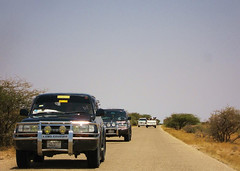 A few minutes later we met up with Issa’s party. There was Issa’s car and his security followed by the Minister for Aviation and his security technical vehicle. We were very pleased and relieved to see them and ecstatic to make it through the buffer zone. I had met Issa in Melbourne before I left for Senegal. We discussed the plan then and during the expedition we have remained in touch. He has put a lot of work into ensuring a successful finish to the expedition, mobilising the support of the whole Puntland State government from the President down.
A few minutes later we met up with Issa’s party. There was Issa’s car and his security followed by the Minister for Aviation and his security technical vehicle. We were very pleased and relieved to see them and ecstatic to make it through the buffer zone. I had met Issa in Melbourne before I left for Senegal. We discussed the plan then and during the expedition we have remained in touch. He has put a lot of work into ensuring a successful finish to the expedition, mobilising the support of the whole Puntland State government from the President down.
Apart from a couple of short breaks this was pretty much a non-stop riding day for me. We did have a tea break after 95km in a small village. From there I cycled directly to Garowe, Puntland’s administrative capital accompanied by an entourage of five vehicles. The whole day was surreal. The plan worked without a hitch, but it is a day I wouldn’t want to repeat. I felt extremely vulnerable, but always felt in control and positive that we would get through. This was Jane’s first day travelling with me – the beginning of her adventure.
Here is a map showing the disputed regions between Puntland and Somaliland: www.bbc.co.uk/news/world-africa-10761968



{ 5 comments… read them below or add one }
hi
u could u pls attach other pictures were is finishing line is and all puntland in picturs
Im glade you made your goal. this was really very, very scarey moment. this is remains me when i was fleeing from mogdisho, and road to kenya what a journey kate this was rally amesing story. a road between Hargeysa and Las anood
Kate it’s excellent to see you passed through puntland. As for the map you provided regarding the disputed area between puntland and somaliland it’s not really disputed at all. The people that live in those so called disputed area are very patriotic bunch of people who don’t want to see somalia divided just like puntland who also doesn’t want to see somalia divided. I mean what is there to divide. We can’t have 500 clans deciding they all want to be “country” can we? lol.
As for the bbc map you posted, the person that is chief of the bbc is from an antagonistic clan who is very anti puntland. You can tell where he highlights “somalia” in the map is where his clan populates lol. It’s kind of weird kate but you won’t understand. Over there clan comes first for everyone and they put their clan first before anything. I mean that bbc map is totally false because where its highlighted somalia “islamist” controls that area called “hizbul iislam and ahlul sunnah” lol. If it was really assessed the only place that stands a chance to be called somalia is puntland because since 1960 somalia indepedence they have also carried the national flag whilst others have had different flags through out different stages of time. I mean even those islamist carry a black flag today.
Anyways I won’t bog you down into somalia politics but there is alot more then meets the eye and just remember “its all clan first” over there. But I am glad you finished your ride successfully and would love to see pictures and stories of your ride through puntland.
can you please show us how u have been welcomed in puntland and the pics of puntland and atleast some details about it. thnxx and congratulation
Congratulations Kate. People like you inspire me every day. We need more people like you. I cant even ride a bike across one block and you went through a whole CONTINENT, AMAZING WOMAN!
Somaliland is proud to be part of your visit and record. We wish you well and thank you for your effort to rise the profile of some of the issues here.
Somaliland is doing well without Somalia and in the future we plan to create our own Tour De France…for local kids and sport lovers.
Cheers and wonderful post!